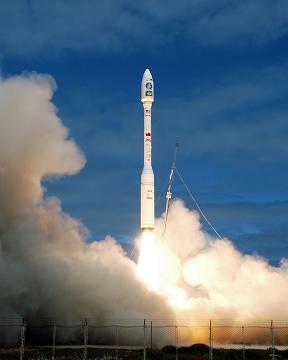The Orbiting Carbon Observatory (OCO) failed to reach orbit on February 24, 2009. OCO launched aboard a Taurus XL vehicle from Vandenberg Air Force Base in California.
OCO was to provide global CO2 measurements from space. The data collected during the mission would have helped scientists understand the global carbon cycle. This understanding is essential to improve the predictions of future atmospheric CO2 increases and its impact on the climate.
NASA appointed an investigation board on March 3, 2009. The members of the Mishap Board for the OCO Investigation are: Rick Obenschain, deputy director at NASA’s Goddard Space Flight Center in Greenbelt, Md., head of the investigation board, Jose Caraballo, safety manager at NASA’s Langley Research Center in Hampton, Va., Patricia Jones, acting chief of the Human Systems Integration Division in the Exploration Technology Directorate at NASA’s Ames Research Center at Moffett Field, Calif., Richard Lynch, Aerospace Systems Engineering, Goddard Space Flight Center, Dave Sollberger, deputy chief engineer of the NASA Launch Services Program at NASA’s Kennedy Space Center in Florida.
The official report of the board contains restricted information, so there is a summary of the report available to the public. The summary contains findings and recommendations regarding the OCO mission failure.
Quote from NASA press release:
“The board identified four potential causes that could have resulted in the fairing not separating:
* A failure of the frangible joint subsystem. A frangible joint is an explosive device that provides instantaneous separation of flight vehicle structures while maintaining confinement of explosive debris.
* A failure in the electrical subsystem that prevented sufficient electrical current to initiate the required ordnance devices.
* A failure in the pneumatic system, which supplies pressure to thrusters which separate the fairing.
* A cord snagged on a frangible joint side rail nut plate”.
The scientific community is also making a strong case for reproducing the OCO mission as soon as possible:
“I think a strong case can be made that the [Orbiting Carbon Observatory] should be reproduced as soon as possible. Here we are, on the verge of new international agreements, without thinking about how to monitor them. We are neglecting climate as an element of national security. We’re not getting the information we need. Where are [climate] changes happening, and where are they going to happen?”
-Ralph Cicerone, President of the National Academy of Sciences
Speaking to Congress, 4 March 2009










 Subscribe to our RSS feed
Subscribe to our RSS feed











There are no comments.
Add A Comment